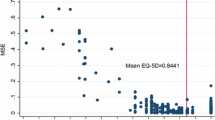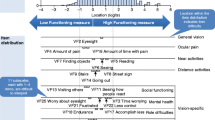Abstract
Purpose
In this study, we explored different statistical approaches to identify the best algorithm to predict EQ-5D utility scores from the NEI-VFQ 25 in patients with age-related macular degeneration (AMD).
Methods
Ordinary least squares (OLS), Tobit, and censored least absolute deviation (CLAD) approaches were compared using cross-sectional data (primary dataset, n = 151) at screening from a phase I/II clinical trial in patients with AMD. Three models were specified in this study: full (includes all 12 dimensions of the NEI-VFQ 25), short (includes only the general health dimension and the composite score), and reduced model (using stepwise regression). To evaluate the predictive accuracy of the models, the mean absolute prediction error (MAPE), mean error, and root means squared error were calculated using in-sample cross-validation (within the primary dataset) and out-of-sample validation using an independent dataset (n = 393). The model that provided the lowest prediction errors was chosen as the best model.
Results
In-sample cross-validation and out-of-sample validation consistently demonstrated that, compared to other approaches, heteroscedasticity-adjusted OLS produced the lowest MAPE (mean values were 0.1400, 0.1593, respectively) for the full model, while CLAD performed best for the short and reduced models (mean values were 0.1299, 0.1483, respectively). The normality and homoscedasticity assumptions of both OLS and Tobit were rejected. CLAD, however, can accommodate these particular violations.
Conclusions
The CLAD-short model is recommended for producing the EQ-5D utility scores when only the NEI-VFQ 25 data are available.




Similar content being viewed by others
References
World Health Organization. (2004). Magnitude and causes of visual impairment. http://www.who.int/mediacentre/factsheets/fs282/en/. Accessed 20 Aug 2007.
Resnikoff, S., Pascolini, D., Etya’ale, D., et al. (2004). Global data on visual impairment in the year 2002. Bulletin of the World Health Organization, 82(11), 844–851.
The Eye Diseases Prevalence Research Group. (2004). Causes and prevalence of visual impairment among adults in the United States. Archives of Ophthalmology, 122(4), 477–485.
Leibowitz, H. M., Krueger, D. E., Maunder, L. R., et al. (1980). The Framingham Eye Study monograph: An ophthalmological and epidemiological study of cataract, glaucoma, diabetic retinopathy, macular degeneration, and visual acuity in a general population of 2631 adults, 1973-1975. Survey of Ophthalmology, 24((Suppl)), 335–610.
Vingerling, J. R., Dielemans, I., Hofman, A., et al. (1995). The prevalence of age-related maculopathy in the Rotterdam Study. Ophthalmology, 102(2), 205–210.
Bressler, N. M. (2001). Photodynamic therapy of subfoveal choroidal neovascularization in age-related macular degeneration with verteporfin: two-year results of 2 randomized clinical trials-tap report 2. Archives of Ophthalmology, 119(2), 198–207.
Ubel, P. A., Loewenstein, G., & Jepson, C. (2003). Whose quality of life? A commentary exploring discrepancies between health state evaluations of patients and the general public. Quality of Life Research, 12(6), 599–607.
Fryback, D. G. (2003). Whose quality of life? or Whose decision? Quality of Life Research, 12(6), 609–610.
Brazier, J., Akehurst, R., Brennan, A., et al. (2005). Should patients have a greater role in valuing health states? Applied Health Economics and Health Policy, 4, 201–208.
National Institute for Clinical Excellence. (2007). Guide to the methods of technology appraisal. Draft for consultation, November 2007. Available at: http://www.rees-france.com/article.php3?id_article=648. Accessed 2 Feb 2008.
The EuroQoL Group. (1990). EuroQol—a new facility for the measurement of health-related quality of life. The EuroQol Group. Health Policy, 16(3), 199–208.
Gold, M. R., Patrick, D. L., & Torrance, G. W. (1996). Identifying and valuing outcomes. In M. R. Gold, J. E. Siegel, L. B. Russell, M. C. Weinstein, et al. (Eds.), Cost-effectiveness in health and medicine (pp. 82–134). New York: Oxford University Press.
Drummond, M. F., O’Brien, B., Stoddart, G. L., & Torrance, G. W. (1997). Methods for the economic evaluation of health care programmes (2nd ed.). Oxford: Oxford Medical Publications.
Mangione, C. M., Lee, P. P., Gutierrez, P. R., et al. (2001). Development of the 25-item National Eye Institute Visual Function Questionnaire. Archives of Ophthalmology, 119(7), 1050–1058.
Chia, E. M., Mitchell, P., Ojaimi, E., et al. (2006). Assessment of vision-related quality of life in an older population subsample: The Blue Mountains Eye Study. Ophthalmic Epidemiology, 13(6), 371–377.
Hudson, H. L., Lane, S. S., Heier, J. S., et al. (2006). Implantable miniature telescope for the treatment of visual acuity loss resulting from end-stage age-related macular degeneration: 1-year results. Ophthalmology, 113(11), 1987–2001.
Ringsdorf, L., McGwin, G., & Owsley, C. (2006). Visual field defects and vision-specific health-related quality of life in African Americans and whites with glaucoma. Journal of Glaucoma, 15(5), 414–418.
Varma, R., Wu, J., Chong, K., et al. (2006). Impact of severity and bilaterality of visual impairment on health-related quality of life. Ophthalmology, 113(10), 1846–1853.
Owen, C., Rudnicka, A., Smeeth, L., et al. (2006). Is the NEI-VFQ-25 a useful tool in identifying visual impairment in an elderly population? BMC Ophthalmology, 6(1), 24. doi:10.1186/1471-2415-6-24.
Age-Related Eye Disease Study Research Group. (2005). Responsiveness of the National Eye Institute Visual Function Questionnaire to progression to advanced age-related macular degeneration, vision loss, and lens opacity: AREDS report no. 14. Archives of Ophthalmology, 123(9), 1207–1214.
Finger, R., Fleckenstein, M., Holz, F., & Scholl, H. (2008). Quality of life in age-related macular degeneration: A review of available vision-specific psychometric tools. Quality of Life Research, 17(4), 559–574.
Austin, P. C. (2002). Bayesian extensions of the Tobit model for analyzing measures of health status. Medical Decision Making, 22(2), 152–162.
Sullivan, P. W., Lawrence, W. F., & Ghushchyan, V. (2005). A national catalog of preference-based scores for chronic conditions in the United States. Medical Care, 43(7), 736–749.
Sullivan, P. W., & Ghushchyan, V. (2006). Preference-based EQ-5D index scores for chronic conditions in the United States. Medical Decision Making, 26(4), 410–420.
Austin, P. C. (2002). A comparison of methods for analyzing health-related quality-of-life measures. Value in Health, 5(4), 329–337.
Fryback, D. G., Lawrence, W. F., Martin, P. A., et al. (1997). Predicting quality of well-being scores from the SF-36: Results from the Beaver Dam Health Outcomes Study. Medical Decision Making, 17(1), 1–9.
Brazier, J., Roberts, J., & Deverill, M. (2002). The estimation of a preference-based measure of health from the SF-36. Journal of Health Economics, 21, 271–292.
Franks, P., Lubetkin, E. I., Gold, M. R., et al. (2004). Mapping the SF-12 to the EuroQol EQ-5D Index in a national US sample. Medical Decision Making, 24(3), 247–254.
Sullivan, P. W., & Ghushchyan, V. (2006). Mapping the EQ-5D Index from the SF-12: US general population preferences in a nationally representative sample. Medical Decision Making, 26(4), 401–409.
Gray, A. M., Rivero-Arias, O., & Clarke, P. M. (2006). Estimating the association between SF-12 responses and EQ-5D utility values by response mapping. Medical Decision Making, 26(1), 18–29.
Koltowska-Häggström, M., Jonsson, B., Isacson, D., & Bingefors, K. (2007). Using EQ-5D to derive general population-based utilities for the Quality of Life Assessment of Growth Hormone Deficiency in Adults (QoL-AGHDA). Value in Health, 10, 73–81.
Buxton, M. J., Lacey, L. A., Feagan, B. G., et al. (2007). Mapping from disease-specific measures to utility: An analysis of the relationships between the Inflammatory Bowel Disease Questionnaire and Crohn’s Disease Activity Index in Crohn’s disease and measures of utility. Value in Health, 10, 214–220.
Wu, E. Q., Mulani, P., Farrell, M. H., & Sleep, D. (2007). Mapping FACT-P and EORTC QLQ-C30 to patient health status measured by EQ-5D in metastatic hormone-refractory prostate cancer patients. Value in Health, 10(5), 408–414.
Dobrez, D., Cella, D., Pickard, A. S., et al. (2007). Estimation of patient preference-based utility weights from the functional assessment of cancer therapy-general. Value in Health, 10, 266–272.
Brazier, J. E., Yang, Y., & Tsuchiya, A. (2008). A review of studies mapping (or cross walking) from non-preference based measures of health to generic preference-based measures. UK: Health Economics and Decision Science (HEDS), School of Health and Related Research (ScHARR), University of Sheffield.
Nichol, M. B., Sengupta, N., & Globe, D. R. (2001). Evaluating quality-adjusted life years: Estimation of the Health Utility Index (HUI2) from the SF-36. Medical Decision Making, 21(2), 105–112.
Franks, P., Lubetkin, E. I., Gold, M. R., & Tancredi, D. J. (2003). Mapping the SF-12 to preference-based instruments: Convergent validity in a low-income, minority population. Medical Care, 41(11), 1277–1283.
Powell, J. L. (1984). Least absolute deviations estimation for the censored regression model. Journal of Econometrics, 25(3), 303–325.
Kennedy, P. (2003). Limited dependent variables. In P. Kennedy (Ed.), A guide to econometric (5th ed., pp. 281–284). Cambridge, MA: The MIT Press.
Soubrane, G., Cruess, A., Lotery, A., et al. (2007). Burden and health care resource utilization in neovascular age-related macular degeneration: Findings of a multicountry study. Archives of Ophthalmology, 125(9), 1249–1254.
Dolan, P. (1997). Modeling valuations for EuroQol health states. Medical Care, 35(11), 1095–1108.
Mangione, C. M., Lee, P. P., Pitts, J., et al. (1998). Psychometric properties of the National Eye Institute Visual Function Questionnaire (NEI-VFQ). Archives of Ophthalmology, 116(11), 1496–1504.
Austin, P. C., Escobar, M., & Kopec, J. A. (2000). The use of the Tobit model for analyzing measures of health status. Quality of Life Research, 9(8), 901–910.
Greene, W. H. (2003). Econometric analysis (5th ed.). Upper Saddle River, NJ: Prentice Hall.
SAS. Version 9.2. (2008). Cary, North Carolina: SAS Institute Inc.
Censored least absolute deviations estimator: CLAD (user-written program). Version Stata 10. (2001). Stata Technical Bulletin. Available at: http://www.stata.com/stb/stb58/sg153/. Accessed 25 Mar 2007.
Forster, M. (2002). Predictive accuracy as an achievable goal of science. Philosophy of Science, 69(s3), S124–S134.
Mooney, C. Z., & Duval, R. D. (1995). Bootstrapping: A nonparametric approach to statistical inference. Newbury Park, CA: Sage.
MacKinnon, J. G. (2002). Bootstrap inference in econometrics. Canadian Journal of Economics, 35(4), 615–645.
Howell, D. C. (2008). The analysis of missing data. In W. Outhwaite & S. Turner (Eds.), Handbook of social science methodology. London: Sage.
Briggs, A. H. (2000). Handling uncertainty in cost-effectiveness models. Pharmacoeconomics, 17, 479–500.
Huang, I. C., Frangakis, C., Atkinson, M. J., et al. (2008). Addressing ceiling effects in health status measures: A comparison of techniques applied to measures for people with HIV disease. Health Services Research, 43(1p1), 327–339.
Gold, M. R., Franks, P., McCoy, K. I., & Fryback, D. G. (1998). Toward consistency in cost-utility analyses: using national measures to create condition-specific values. Medical Care, 36(6), 778–792.
Macran, S., Weatherly, H., & Kind, P. (2003). Measuring population health: a comparison of three generic health status measures. Medical Care, 41(2), 218–231.
Luo, N., Chew, L. H., Fong, K. Y., et al. (2003). A comparison of the EuroQol-5D and the Health Utilities Index mark 3 in patients with rheumatic disease. Journal of Rheumatology, 30(10), 2268–2274.
McIntosh, L., Kymes, S. M., Perron, B. B. M., et al. (2008). Truth and consequences: Assessing the relationship between health and vision related quality of life. Eyes on Innovation, the ARVO 2008 Annual Meeting. April 27–May 1. Fort Lauderdale, Florida.
Financial disclosures
This study was part of a research contract to Purdue University (Kent H. Summers, PI, a former employee) funded by Pfizer Inc. Nalin Payakachat received a graduate research assistantship from this contract through Purdue University.
Author information
Authors and Affiliations
Corresponding author
Rights and permissions
About this article
Cite this article
Payakachat, N., Summers, K.H., Pleil, A.M. et al. Predicting EQ-5D utility scores from the 25-item National Eye Institute Vision Function Questionnaire (NEI-VFQ 25) in patients with age-related macular degeneration. Qual Life Res 18, 801–813 (2009). https://doi.org/10.1007/s11136-009-9499-6
Received:
Accepted:
Published:
Issue Date:
DOI: https://doi.org/10.1007/s11136-009-9499-6




